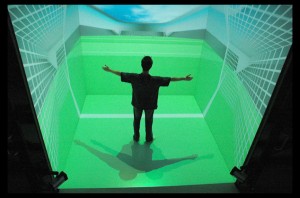The digital revolution is a half-century old but for most of us our interaction with it comes through a keyboard and mouse. Our software applications respond to clicks and keystrokes. This is not a barrier to entry for the vast majority of humans, but for those with physical disabilities and for other intelligent species on this planet this interface represents a difficult hurdle.
Our Human Communication Limits
We humans interact with our world through five senses – sight, sound, taste, touch and smell. For those who suffer from blindness or sight problems a video display is a barrier to communication. For those who are deaf, a sound byte without pictures is useless. For those who suffer from disabling impairments to limbs, a keyboard and mouse have little value.
Most humans communicate in one language. A few of us are multilingual. Think how much our lack of facility with language limits our ability to communicate with other humans who speak and think in a different language.
Communication through taste and smell are better developed in other species than in humans and we are only beginning to consider ways to develop the equivalent chemistry and technology to that which nature has given dogs.
Even communication through sound in us is limited. Many species hear sounds we cannot. Many animals use sound to visualize the surrounding environment. Whales, dolphins and bats use echo location to see and touch. We have developed artificial equivalents through technologies like sonar and radar.
Through the application of technology we have begun to address and supersede our own sensory limitations, not just for those of us who have all our senses, but also for those of us constrained by the loss of one or more.
Overcoming Physical Disability through Immersive Technology
“Accessibility is far more than opening physical doors, building ramps and widening corridors; ultimately, it’s about striving to enable accessibility to all aspects of society.” I read this quote in a recent article that appeared in Canadian Health & Lifestyle Magazine. The article focused on sensory therapy for children with complex disabilities.
In my past work I had explored looking at multi-sensory environment technology for people who had experienced catastrophic injury. I spent some time visiting a developer of immersive virtual reality in Toronto accompanying a friend of mine who is quadriplegic. My friend and I had worked together on speech and voice recognition technology for computer command and control back in the 1990s. We had tried all kinds of speech recognition software applications back then, settling on DragonDictate, a concatenated speech engine. We developed macro libraries that could recognize a short phrase and launch associated standard blocks of text, or speech commands that could format and design a document. Today you can find continuous speech engines that are the successors to the voice recognition technology first pioneered in the late 1980s and 1990s.
But I digress because I wanted to describe what we saw that day in a Toronto downtown office, an immersive technology that through a blink of an eye, or a simple finger gesture caused the wind to rustle leaves across a landscape, or caused ripples to appear on the surface of a pond. The technology created this sensory environment using strategically located projectors and motion detectors. For my friend confined to his wheelchair it gave him the virtual reality experience without the impediment of having to wear headgear. To appreciate what he experienced that day watch a video of a young man with a brain injury paddling a virtual canoe through rapids.

Needless to say, after seeing this type of interface between an individual with a significant disability and a virtual environment it became clear to me that there were many other ways to break down barriers to communication, both voice and physical that I had yet to experience. So I began to do research on technologies that could improve accessibility to the world around us for those we define as disabled. That got me thinking about other communication barriers both between humans as well as those between us and other animal species.
Some of what I will describe in future blogs on this subject you may perceive as far fetched but I don’t think so. Here are just a few of the subjects we will explore:
Helping the Blind See Through Sound and Other Technologies
Unlocking the Locked In by Communicating Directly with the Brain
Searching for a Universal Translator
Speaking with Dolphins and Other Animal Species
What will our world of communication be like in 2100? A world in which humans will freely communicate regardless of language limitation. A world in which those defined as disabled today will be empowered and enabled like never before. A world in which humans will interact and communicate with many animal species. And maybe even a world in which we will have made first contact with extraterrestial species because in unlocking our ability to communicate with non humans on this planet we will have created the key for communicating with those not from this planet.








